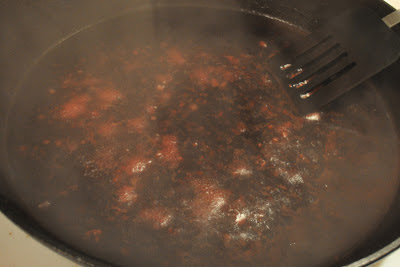First of all, hail to my readers in France, Sweden, Canada, Germany, Spain, and Ukraine! Welcome to "To Thine Own Self, Be Food"!
It looks like I'm in a rhyming mood today...which I've just now gotten out of my system.
Today we're going to have some choice words about that most primal protein: beef.
If I had a dollar for every time a restaurant made a misteak on cooking my piece of meat, I'd have enough money for a half-tank of gas.
The solution was to learn how to cook meat to my exact specification. But, it was daunting. I mean, meat and fire is the domain of man, right? Man grill, bring woman food! I didn't want to emasculate my husband by taking that away from him, but, by golly, how many times was he going to give me a medium-well steak when I wanted medium-rare!?
Well...in the words of Shakespeare, sometimes you have greatness thrust upon you. I am doing a cooking demonstration for the winery folks tomorrow that consisted of preparing a red wine reduction sauce for steak. That's not the problem. Boil liquid until thick. However, I've got to serve this sauce with meat. Steak. The recipe calls for searing it before finishing it in the oven.
Even though I haven't seared anything before, I understand the concept. A skillet is heated (no fat or liquid added) to medium-high heat. Throw in meat in pan and brown (the fancy word for 'browning' is Maillard reaction, by the way) on both sides. The sugars on the meat's surface brown quickly (caramelization), which means the outside cooks fast, leaving the insides rather raw. Some people like eating their meat this way. Most don't, hence the little extra roasting time in the oven.
First up, a skillet. Cast-iron works nicely, if you got it. Salt and pepper the meat liberally.
And, then the important part...don't touch it the meat for about 3-5 minutes. If you lift it up too early and it sticks to the pan, the caramelizing's not happening. Another 3 minutes on the other side, and voila! - Seared Meat! I threw the slabs on a baking sheet, covered them with foil, and banged them in my 200 degree oven to finish cooking while I made the reduction sauce.
Two cups of red wine (Merlot) and shallots were added to the hot, crusty cast-iron skillet. Boiling immediately begins to reduce the amount of liquid, and I let it go until about half was left in the pan. Then, I added a cup of beef broth (reduced down from two cups) to the mess. At this point, the sauce is still pretty runny, so I did a cornstarch slurry (teaspoon cornstarch and water) to thicken things up. This whole sauce is roughly a 25-30 minute process, mostly consisting of liquids that are boiling down in the pan.
And here it's spooned over my perfectly cooked, perfectly pink meat. I feel pretty good - I am on my way to conquering meat!
It looks like I'm in a rhyming mood today...which I've just now gotten out of my system.
Today we're going to have some choice words about that most primal protein: beef.
If I had a dollar for every time a restaurant made a misteak on cooking my piece of meat, I'd have enough money for a half-tank of gas.
The solution was to learn how to cook meat to my exact specification. But, it was daunting. I mean, meat and fire is the domain of man, right? Man grill, bring woman food! I didn't want to emasculate my husband by taking that away from him, but, by golly, how many times was he going to give me a medium-well steak when I wanted medium-rare!?
Well...in the words of Shakespeare, sometimes you have greatness thrust upon you. I am doing a cooking demonstration for the winery folks tomorrow that consisted of preparing a red wine reduction sauce for steak. That's not the problem. Boil liquid until thick. However, I've got to serve this sauce with meat. Steak. The recipe calls for searing it before finishing it in the oven.
Even though I haven't seared anything before, I understand the concept. A skillet is heated (no fat or liquid added) to medium-high heat. Throw in meat in pan and brown (the fancy word for 'browning' is Maillard reaction, by the way) on both sides. The sugars on the meat's surface brown quickly (caramelization), which means the outside cooks fast, leaving the insides rather raw. Some people like eating their meat this way. Most don't, hence the little extra roasting time in the oven.
First up, a skillet. Cast-iron works nicely, if you got it. Salt and pepper the meat liberally.
And, then the important part...don't touch it the meat for about 3-5 minutes. If you lift it up too early and it sticks to the pan, the caramelizing's not happening. Another 3 minutes on the other side, and voila! - Seared Meat! I threw the slabs on a baking sheet, covered them with foil, and banged them in my 200 degree oven to finish cooking while I made the reduction sauce.
Two cups of red wine (Merlot) and shallots were added to the hot, crusty cast-iron skillet. Boiling immediately begins to reduce the amount of liquid, and I let it go until about half was left in the pan. Then, I added a cup of beef broth (reduced down from two cups) to the mess. At this point, the sauce is still pretty runny, so I did a cornstarch slurry (teaspoon cornstarch and water) to thicken things up. This whole sauce is roughly a 25-30 minute process, mostly consisting of liquids that are boiling down in the pan.
And here it's spooned over my perfectly cooked, perfectly pink meat. I feel pretty good - I am on my way to conquering meat!



Comments
Post a Comment